Introduction
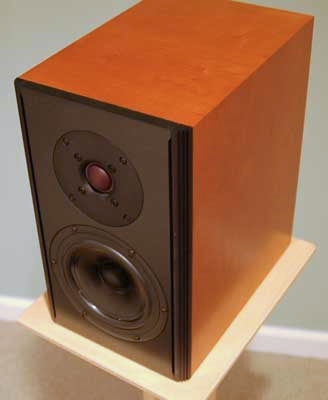 Outlaw Audio, those “Internet only” rebels lead by head wrangler Peter Tribeman, have finally satisfied a large following by entering the speaker market. Now along with SSPs, amplifiers, subwoofers, and any number of audio accessories, the Outlaw line is further extended by offering the compact BLS bookshelf speaker.
Outlaw Audio, those “Internet only” rebels lead by head wrangler Peter Tribeman, have finally satisfied a large following by entering the speaker market. Now along with SSPs, amplifiers, subwoofers, and any number of audio accessories, the Outlaw line is further extended by offering the compact BLS bookshelf speaker.
The effervescent Mr. Tribeman is not new to speakers; his Atlantic Technology line has impressed home theater enthusiasts and audiophiles, receiving critical accolades. The Outlaw rooms at the Home Audio Shows are typically full and always leave a lasting impression from quality and performance to the unbelievably modest pricing.
BLS Monitor
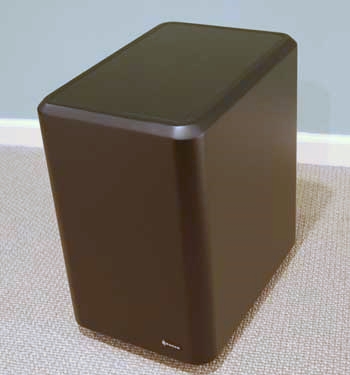 Well why not start with the basics? The BLS bookshelf speaker is smartly designed as a rectilinear enclosure to be placed on stands, shelves, in bookcases, or entertainment units. The BLS offers adjustments, depending on the particular situation, so read on.
Well why not start with the basics? The BLS bookshelf speaker is smartly designed as a rectilinear enclosure to be placed on stands, shelves, in bookcases, or entertainment units. The BLS offers adjustments, depending on the particular situation, so read on.
On the rear, along with a pair of five-way binding posts for bi-wiring or bi-amplification, already unusual for a speaker at this price, are two extremely unusual switches. As “Room Compensation” is the catchphrase du jour, Outlaw does one better by offering a high-frequency adjustment that boosts or lowers the tweeter output by 2 dB.
This fine tuning may make the difference in any room when controlling brightness due to glass, or hard floors and walls. Likewise, sonically dead rooms with too much heavy drapery or furniture may require a bit more edge to the highs.
Specifications
BLS
- Drivers: One 1″ Tweeter, One 5.25″ Woofer
- MFR: 54 Hz – 22 kHz ± 3 dB
- Nominal Impedance: 8 ohms
- Efficiency: 87 dB
- Power Handling: 50-200 Watts
- Dimensions: 12″ H x 7.25″ W x 11″ D
- Weight 16.5 Pounds/ Each
- MSRP: $1,099/Pair USA
LFM-2
- Driver: 8″
- Amplifier: 150 Watts RMS
- MFR: 25 Hz – 180 Hz ± 2 dB
- Dimensions: 17″ H x 16.5″ W x 11.25″ D
- Weight: 37 Pounds
- MSRP: $299 USA
A secondary switch usually seen on subwoofers is a Boundary Compensation switch – using it is based on the placement of the speaker, whether it’s in a bookcase, near a wall or corner, or out in the open. The switch has three positions including 0 dB or no compensation, and -2 dB or -4 dB specific for the upper bass frequencies.
The Outlaw BLS stands a modest 12″ high, almost 11″ deep, and just over 7″ across, and weighs 16.5 pounds. The enclosure is of typical rigid and dampened MDF. Two conservative finishes are available in either hand-painted black or a lovely cherry veneer for a slight up-charge and in my opinion, well worth it if you’re planning on placing them out in the open.
The grille is unusual in that it’s perforated metal not fabric, and is held in place with a slot running the entire length top to bottom on both sides of the face. Felt pads are provided to keep the bottom of the speaker from sitting directly on the surface.
The BLS is modestly sensitive at 87 dB, can handle up too 200 watts, and has a nominal impedance of 8 Ohms. The fully shielded tweeter is a 1″ silk dome said to be linear up to 22 kHz. The bass is handled by a 5 ¼” SEAS woofer which will drop down to a respectable 54 Hz as specified.
After all the discussion of placement flexibility, I am surprised to see the unit is rear-ported. So, you have to be careful about putting it too close to the wall behind a bookcase shelf.
LFM Subwoofer
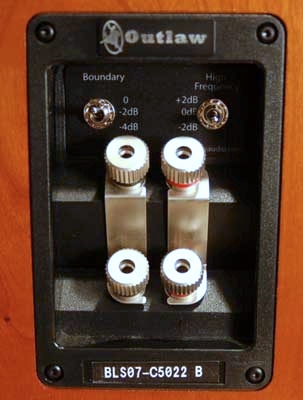 It’s more common nowadays that audiophiles practice some bass management than in the past, or are at least open to the idea of monitor speakers for mains, augmented by a separate subwoofer.
It’s more common nowadays that audiophiles practice some bass management than in the past, or are at least open to the idea of monitor speakers for mains, augmented by a separate subwoofer.
Full range floor speakers that truly get down to the low frequencies expected from great recordings are rare and expensive. Pairing just about any speaker, but especially a bookshelf model, with a subwoofer, makes good sense.
Outlaw has produced some exceptional subwoofers in the past, and their current lineup is certainly no exception. Along with the BLS speakers, they sent an LFM, or Low Frequency Module, a.k.a., subwoofer.
The LFM is available in two models: the LFM-1 with a 12″ driver and 325 WRMS, and the smaller LFM-2 (which I received) with an 8″ driver and 150 WRMS.
The LFM is actually a beautiful unit – the top is mirror-like piano black, while the sides are low luster. Not all that compact however, the 37 pound LFM-2 sports an 8″ down firing long-throw woofer, stands 17 inches tall, 16.5 inches wide, and more than 11 inches across.
The rear sports everything you’d expect to find from Outlaw: An auto on/off switch with detachable power cord, along with a phase switch, volume control, and crossover control from 30 Hz to 90 Hz, line-level inputs and outputs. And lastly, it does have a crossover bypass switch if an external crossover is used. The sophisticated crossover network is a 4th order low pass.
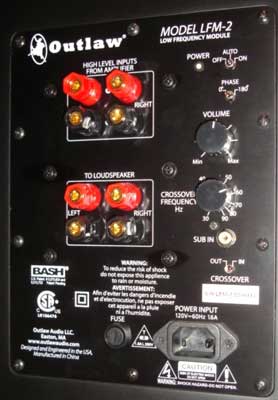 The LFM-2 is single-ported on the bottom. To insure proper height from the floor, Outlaw provides “dimple discs” for the mounted carpet spikes. Certainly the main reason is to preserve floors from damaging spikes, however, I found them convenient on carpet as well, floating the speaker every so slightly higher. This made me more comfortable allowing more air between the woofer/port and the floor.
The LFM-2 is single-ported on the bottom. To insure proper height from the floor, Outlaw provides “dimple discs” for the mounted carpet spikes. Certainly the main reason is to preserve floors from damaging spikes, however, I found them convenient on carpet as well, floating the speaker every so slightly higher. This made me more comfortable allowing more air between the woofer/port and the floor.
If I were running a surround package here, I’d definitely take two!
Manuals
It’s usual that I’d commend the owner’s manuals enough to give one its own heading, but frankly I’m totally impressed with Outlaw’s succinct manuals for their clarity and advice.
The text is easy to follow and explained – all modesty aside, sometimes manufacturers overestimate their client’s experience with such products. From connections to placement, Outlaw smartly explains how to best take advantage and to realize the potential in the component.
Setup and Listening
During the early break-in period, a variety of sources were used for amplification, including the ample LFM subwoofer line-level inputs from my integrated. Having said that, no less than three amplifiers were used, all two-channel. On hand were also a wonderful solid state integrated from McIntosh (review on the way) and the thoroughly enjoyable combination of the Rogue Perseus tube preamp with a hefty ADA (Audio Design Associates) solid state amplifier.
Although there are some incredible differences between these sources, the BLS adapted well to all, yet I found my first intuition to pair it up with a modest tube amp to be a wonderful combination. In the end, it was my superb Onix SP3 33 watt integrated to be the ideal match with the BLS speaker, so for the most part most of my comments are from this setup.
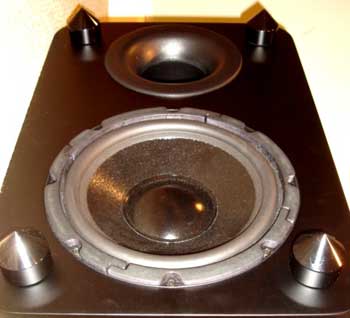 Other sources included a Marantz turntable and a McCormack universal DVD player, Goertz interconnects and speaker cables, along with upgraded Wireworld power cords. All connected to a massive Torus Power isolation unit.
Other sources included a Marantz turntable and a McCormack universal DVD player, Goertz interconnects and speaker cables, along with upgraded Wireworld power cords. All connected to a massive Torus Power isolation unit.
I chose to match the BLS with my modest-sized listening room, measuring 12 feet across and 15 feet deep, with 7.5 foot ceilings. I’m certain after some playing time that the Outlaw units can handle a larger room, but to give the BLS the best opportunity for imaging and soundstage, this space was a good fit.
One of the reasons this room was chosen, not that I have so many rooms to audition speakers, was that it has a permanent shelf/bench behind the along listening room wall, so I felt it best simulate the potential for the BLS to be bookcase or shelf mounted. This proved to be an exceptional experiment, as the compensation adjustments afforded on the speakers worked nicely as designed.
I thought I’d work my way from the back wall forward, first playing the BLS without the LFM and then combine it with the subwoofer as the speaker made its way into the room away from walls. All the while adjusting the compensation switches as I felt necessary.
I also thought it might be interesting to concentrate on one CD for the entire review as the variety afforded of placement, adjustments, compensations, and using/not using the subwoofer, provided the variables. The CD I chose was the new Alison Krauss/Robert Plant duet, Raising Sand. Why? Because it has both male and female vocals, along with a variety of musical genre from mystical rock to folk, as well as a variety of instruments. And I was curious about this anticipated album, yup I can say that, it’s out on vinyl too.
My first auditions excluded the LFM subwoofer to afford the BLS some time alone, as the bass resonance from the rear wall quickly had me leaping to lower the boundary switch to the lowest setting – the bass was overwhelming in its location.
Putting the issue aside for the time being, I just closed my eyes and listened. The BLS doesn’t resemble its modest size, with the soundstage wider than the 6 feet apart I placed them, by as much as several feet to each side. Through the BLS, Alison Krauss’ voice was nicely rendered, and as a duet, her voice is just in front of the speaker plane and Robert Plant’s slightly back, even when he’s the lead voice. My first thumbs-up for the BLS was with voices – simply superb.
I resisted removing the speaker from the shelf until I was able to hear the entire CD. Consistent was the rear wall effect on bass and definition. Rear ported, the BLS pushed a lot of air out the back. If this were my final location, I’d forgo the subwoofer.
Placing the BLS on stands about three feet from the rear and side walls, and switching off the boundary reduction, Plant’s voice was brought further forward, yet air remained between his voice and hers. Guitars became more apparent and articulate. Percussions become more vibrant, although a bit lacking in the low end, understandably.
Stopping the playback and integrating the LFM-2 subwoofer brought the bass guitar back and made the bass drum fuller. Alison’s fiddle was warm, yet defined and rich. Midrange, another thumbs-up!
The LFM subwoofer wasn’t the main goal for this review, yet I’ve always been impressed by the Outlaw subwoofer line. Having as many as four in a room yielded typically some of the best surround experiences at the audio shows, so the Outlaw subwoofers are impressive considering their very reasonable pricing.
Track 8 “Trampled Rose” is a melodic mix of Alison’s sultry voice, a plucking Dobro, (steel guitar which is almost mandolin sounding), and deep distant drums. The Outlaw BLS/LFM combination left me mesmerized and wanting more.
I felt the BLS came into their own after a number of hours playing as the music became more revealing, highs more extended and timing more accurate. The final track 13, “Your Long Journey” is vintage Krauss bluegrass. Riley Baugus’ banjo was surprisingly elegant and edgy.
Conclusions
So there you have it, Outlaw Audio’s first foray into the competitive speaker world is highly successful, and I can’t wait to see what they do next – perhaps full range units?
I will say placing the unit is critical to get the most from this compact speaker. My preference was away from the wall on substantial stands with the modestly priced LFM-2 squarely between them.
I truly can’t stress enough how worthy I found the BLS from Outlaw Audio. The more I played them, the more I liked . . . no, loved them. In fact I did wonder what five would sound like spaced around my room with some high resolution audio! Needless to say I could imagine.

